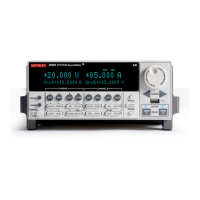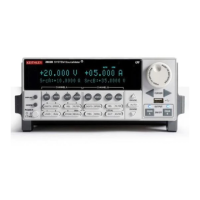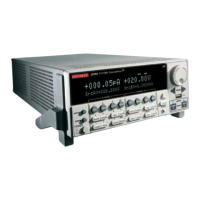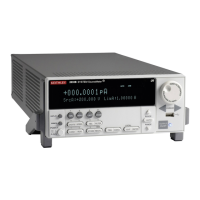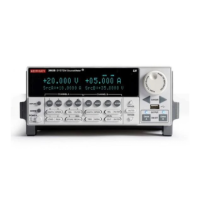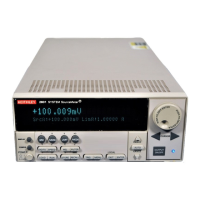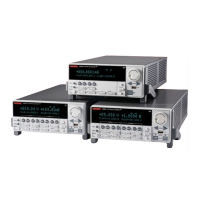3-4 Return to Section Topics 2600S-900-01 Rev. C / January 2008
Section 3: Test Script Processor Interaction Series 2600 System SourceMeter
®
Instruments User’s Manual
points 3
The following command will execute the PulseVMeasureI function using the above parameters:
PulseVMeasureI(smua, -1, 1, 1E-3, 2E-3, 3)
Step 2: Read the buffer
Reference See in Section 7 of the Series 2600 Reference Manual for more details on the
reading buffers.
The above function stores the three current measurements in the reading buffer
(
smua.nvbuffer1). Also stored in the buffer are the voltage source settings and timestamps for
the measurements. The timestamps (in seconds) are referenced to the start of the test. The timer
for the timestamps starts at zero seconds when the test is started.
The printbuffer function is used to print (output) measured readings, timestamps and/or source
values stored in the buffers.
Print readings – The following code will return the three measured current readings stored in
nvbuffer1:
rb1 = smua.nvbuffer1
printbuffer(1, rb1.n, rb1)
Example output: 1.234567e-03, 2.362360e-03, 2.362368e-03
For the above printbuffer function, 1 is the starting index for values to print, rb1.n is the
ending index (for this function,
n = 3), and rb1 is the reading buffer (smua.nvbuffer1).
Print time stamps – The following command will print the time stamps for the three measured
current readings:
printbuffer(1, rb1.n, rb1.timestamps)
Example output: 5.555555e-02, 8.888888e-02, 1.111111e-01
Print source values – The following command will print the voltage source values for the three
measured current readings:
printbuffer(1, rb1.n, rb1.sourcevalues)
Output: 1.000000e+00, 1.000000e+00, 1.000000e+00
Print readings, time stamps and source values – The following command will return the three
sets of data (nine values) in the same message:
printbuffer(1, rb1.n, rb1, rb1.timestamps, rb1.sourcevalues)
Example output:
1.234567e-03, 5.555555e-02, 1.000000e+00, 2.362360e-03, 8.888888e-02,
1.000000e+00, 2.362368e-03, 1.111111e-01, 1.000000e+00
The above output is returned in the following order:
reading1, timestamp1, sourcevalue1, reading2, timestamp2, sourcevalue2, reading3, timestamp3,
sourcevalue3
Calling a function without parameters
When the command to call a script function is sent without parameters, input value fields and
messages will appear on the display to prompt the operator to input the parameters using the front
panel controls.
The following command will call the SourceVMeasureI function and then require operator
interaction:
PulseVMeasureI()
